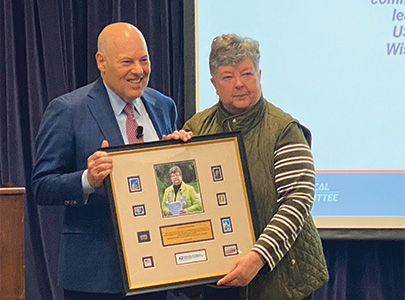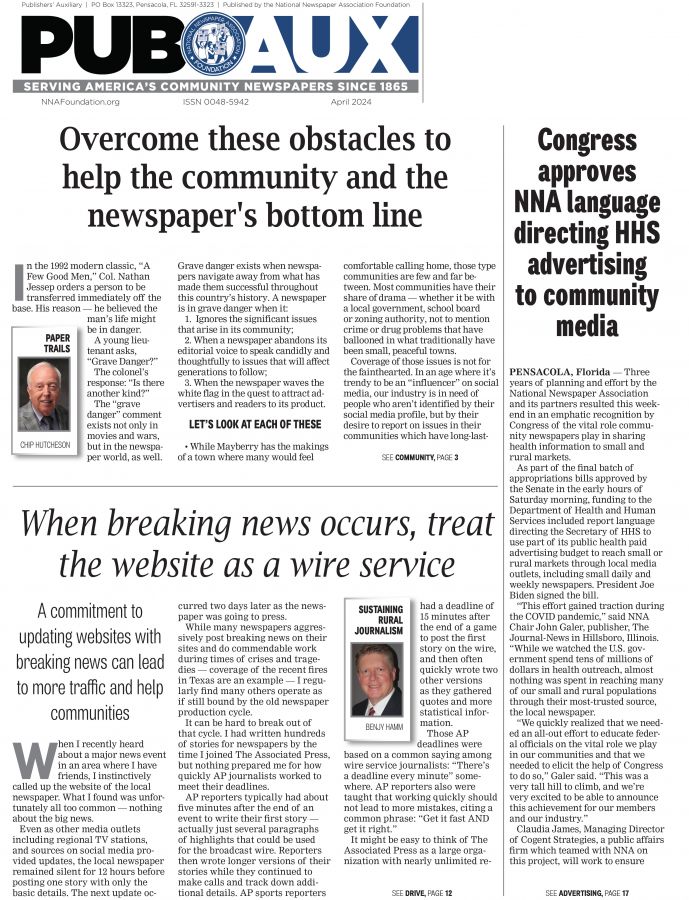The Universe opens a window on the world
Sep 8, 2016
Campus newspapers are by nature hyperlocal, covering their universities like small town mainstream newspapers cover their communities. And like newspapers all over the country, the world of digital publishing has impacted the way college newspapers operate, including Brigham Young University’s newspaper—The Universe.
By Teri Saylor
Special to Publishers’ Auxiliary
Campus newspapers are by nature hyperlocal, covering their universities like small town mainstream newspapers cover their communities. And like newspapers all over the country, the world of digital publishing has impacted the way college newspapers operate, including Brigham Young University’s newspaper—The Universe.
The Universe, published by BYU’s School of Communications, is living up to the name it has displayed since 1954. Originally titled “The Daily Universe,” the newspaper has expanded beyond the campus microcosm into the global arena. It was converted to a “digital first” publication in 2012 when it switched its daily print product to a weekly newspaper and dropped “Daily” from its nameplate.
Although technology might be blamed for cutting a daily into a weekly publication, management doesn’t see it that way. Neither Universe director Steve Fidel nor former editor, Alex Clark, views the change as a loss. Instead they look at what they have gained: an open window on the world. Today, The Universe covers the news of the BYU campus, the city of Provo, all of Utah and beyond.
BYU’s mottoes over the years have been “The World is our Campus,” and “Enter to Learn; Go Forward to Serve,” and they seem to be a perfect fit for the name and goals of the newspaper, according to Fidel.
“We claim The Universe as a way to encourage students to think big—beyond the grounds of this campus,” he says.
Fidel, who serves as an adjunct professor in the School of Communications and as the newspaper’s director, is a career newsman. A BYU graduate with a degree in mass communication, he came to Provo for his education and never left. He has successfully traversed the newspaper landscape, starting at the Deseret News as a reporter and moving on to positions as print and online editor, eventually launching the newspaper’s first mobile electronic edition. He also managed a news partnership between the Deseret News and KSL TV before the two organizations merged in 2010. He continued to work as a multi-platform journalist with KSL before moving to BYU in 2012 to manage The Universe.
At the college newspaper, the transition to digital media has been relatively smooth and seamless.
“I first started teaching here in 1999, when people thought computers were cool, way cooler than newspapers,” he says. “Starting in 2012, we began reinforcing our digital presence and the mindset that we are a news organization as opposed to a paper product.”
But along the way, the printed newspaper has developed a new prestige, even among college students, who perceive that only the best articles make it into the print edition because the limited space is more precious.
“The lesson here is that our boundaries are not as well-defined,” Fidel said. “Consumers need to be savvier, and producers need to be more discriminating in their coverage. Today, there is vast news coverage across many platforms.”
Clark, a senior who just wrapped up a semester as editor of The Universe, grew up in a digital world. Online news is natural for him, and unlike middle-age editors who grew up as ink-stained wretches, Clark’s media world has centered on keyboards, screens and the web. Along the way he has developed an appreciation for print and understands how the two mediums can work hand in hand.
For young editors like Clark, the way news is packaged doesn’t really matter. But what is important may surprise old school journalists.
Today’s youth accepts and embraces bias in the media, although Clark understands traditional journalism strives for neutrality.
“This generation is accustomed to the fact that everyone has a bias, and we have come to expect it,” he said. “We are prepared to seek out multiple perspectives in order to make up our mind and shape our viewpoints.”
The Universe is not an independent newspaper. Brigham Young’s Office of University Publications set it up as a lab newspaper, and there is a direct relationship between the classroom and the newsroom. But although The Universe is an official organ of BYU, the administration doesn’t edit the content, Fidel said. And he sees this as an earned privilege.
“Our kids know they have to do a good job,” he said.
And as a newspaper on the global stage, the stakes are high.
To even have a chance to work for their newspaper, students first have to make it into the BYU communication program, which carries three tracks: advertising, journalism and public relations. Enrollment is limited and it is competitive.
Today, The Universe has a staff many daily newspapers would envy. In addition to 30 or 40 newsroom staff, the newspaper has a web editor, designers, ad sales staff, and a team of business students who handle the business end of publishing. The entire staff gets a holistic view of publishing and learns what it takes to make a news organization run. Advertising sales pay all of the newspapers expenses, including Fidel’s salary.
Fidel selects and supervises the newspaper’s editor. The two meet daily and make the news planning decisions. Typically, the editor serves for a single semester and is required to work internships, often landing prestigious positions. One student landed a job at Facebook, helping launch Facebook News. Another student took an internship at Newsweek and ended up as political editor of Buzzfeed, according to Fidel.
“All our students are multimedia journalists who write, shoot photography and video and do their own editing,” Fidel said. “The world is changing, and there are so many opportunities for where they can go from here.”
Clark, who has worked internships at KSL and Salt Lake online, originally wanted to become a sports reporter. His dad is a football coach, and he grew up loving sports writing.
Fidel forced Clark out of that niche when he named him as editor, and today, his appreciation for journalism has expanded well beyond sports. He will work as the newspaper’s web editor during his final semester at BYU, and after graduating, he’s planning to go to law school to study constitutional law, focusing on the First Amendment.
“Since coming to Brigham Young, I have become interested in religious freedom,” he said. “I would like to use a law degree and use my journalism skills to focus on religious liberties.”
A focal point in The Universe’s newsroom is a set of three large computer monitors mounted on a wall. They display streaming analytic reports on the website and social media platforms The Universe uses.
Fidel described the newspaper’s coverage of a mixup on a slogan the BYU’s athletic department printed on T-shirts in 2014 to promote the school’s football team. “Rise As One” took off, but as The Universe reported, the slogan was intercepted because of a copyright violation.
“Further, the Mormon Church mandates that you don’t drink alcohol, and not only was that slogan trademarked, it was trademarked by Anhaeuser Busch,” Fidel said.
When The Universe’s story launched on a Friday afternoon, the staff put a link to it on Twitter and then watched the monitors. KSL saw the tweet and retweeted it. Then five minutes later ESPN picked up the story. It went viral right before their eyes.
“So here were these kids standing in front of the monitors with their old nutty professor, reading analytics in real time,” Fidel said. “We just stood there, watching the analytics pour in. You can’t teach this stuff.”
The Universe uses several analytics platforms including Google, Chartbeat and NUVI, all of which pick up on trends, focusing on hashtags and keywords.
“News decisions can be based on what is getting traction around the globe, and analytics can help determine what resonates,” Fidel said. “When our student journalists watch the analytics and see the impact they have, they take their work more seriously.”
For Clark, it is this global audience that makes The Universe special.
“By nature, we have a large internet audience. The Church of Jesus Christ of Latter Day Saints and Brigham Young University provide a readership around the world, and when we study our analytics, we see readers from all over the world visiting our website,” he said. “The Universe is special because it is so diverse. We write about things that affect the entire world, but from our local perspective.”
When Fidel was a journalism student in 1977, the world was transitioning to computers.
“We had just gotten a computer system in the newsroom,” he said. “At the Deseret News, things changed so rapidly, I was allowed to do new things. That’s where I learned how to use a web browser and e-mail.”
Nearly 40 years have passed since Fidel graduated from college, and he is grateful for being able to experience how the internet has enabled newspapers to have a 24-hour news cycle.
His advice for publishers is, “don’t panic. Journalists are doing themselves and their industry a disservice to tell people that newspapers are dying. We need to evaluate where the audience is and how to best serve it—and how to make money doing it.”
Even Clark, who represents the generation of young journalists who have known nothing but digital media, believes in newspapers, and is savvy enough to avoid making any predictions.
“If I could predict the future of news, I’d make a lot of money,” he said. “I think the digital side will continue to be important, but traditional media won’t go away. The death of newspapers is overblown, and there is still a lot of power in print. People look up to those news sources, and that’s what is important.”
Details
Name of newspaper: The Universe.
What is The Universe’s print circulation and overall readership? Print circulation is 10,000 weekly.
What is its publication schedule? We publish every Tuesday.
Does the newspaper have a mission statement or a motto? If so, what is it? There isn’t a mission statement per se. The line “Serving the Brigham Young University Community” appears beneath the mast, and that could be considered our motto.
How many staff work on The Universe? Thirty-five to 40, depending on the time of year.
What is your news organization’s role in the community? BYU faculty often say the student work in The Universe provides “the window outside their classroom into the lives of their students.” University faculty and staff are a major portion of The Universe’s readership. The Universe is also an important information source for students, who need to know what is happening in the “campus world” around them. The Universe is typically the exclusive source of news about campus crime. Alumni and the parents of students are a significant part of The Daily Universe’s online audience. The advertising content is also important across the readership spectrum.
What is the most rewarding aspect of publishing a student community newspaper? The university population is equivalent to some of the largest cities in the state—twice that when you consider none of the BYU population is too young to read. That makes The Universe a major information source for a significant and highly educated population, which is a great opportunity and responsibility. The university environment also breeds creativity and allows Universe leadership to work with emerging technologies so that students are ahead of the industry generally when they transition to the workforce. Camera drones are one example. We have had a drone for more than two years and have incorporated it into our teaching, policies and practices.
What are your biggest challenges? Staffing, since the newsroom population turns over continually; and keeping a competitive edge financially in a world where advertisers have so many options.
How can community newspapers best serve their readers in today’s multi-platform environment? The default answer here is to be hyperlocal, and I’m on board with that. Understanding the best way to do that requires the kind of promotion that newspapers haven’t done as well, historically, but that radio stations have understood for some time by continually reaching out to their audience and letting them know what content they have. In today’s environment, the newsroom needs to know what its audience is looking at. In the case of a university, where the audience has cores in the 18-25 range and in the 40-65 range, that means keeping a strong presence in print, online and on social media. The Universe daily posts and promotes its content on all major social media platforms except Snapchat.
What are your top goals for 2016-2017? The Universe will have two commercially licensed drone pilots soon. One goal will be to more fully acclimate the community around us (including law enforcement, an active medical helicopter landing pad and a commercial airport) to the presence of a news drone. That goal is complicated by the abundance of negative news about drones, so this will take some work. Another goal is to keep sharp our ability to be nimble and better use emerging technologies to keep our audience engaged.
Website: www.universe.byu.edu
Phone Number: 801-422-2957 (news)
E-mail: steve.fidel@byu.edu














